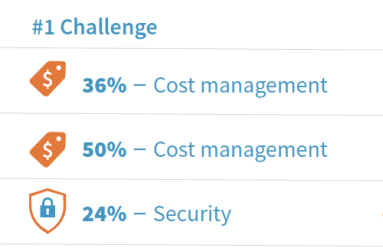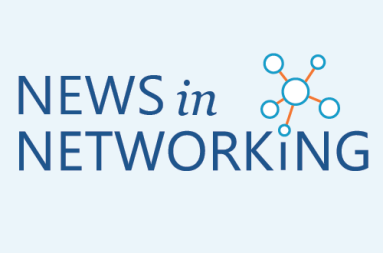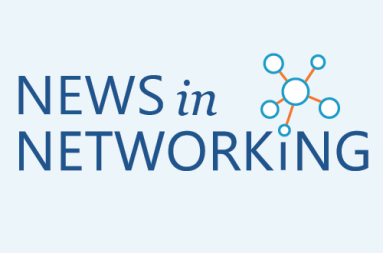Posts by Michelle Kincaid

























About Michelle Kincaid
Michelle Kincaid is the director of communications for Kentik. Previously, she ran a cybersecurity news site in Washington, DC and then moved to San Francisco to run public relations programs for US and EMEA-based cybersecurity startups. In 2015, while serving as a director at global communications agency LEWIS, Michelle met Avi Freedman and the Kentik (then-CloudHelix) team and served as a PR consultant for the company’s launch from stealth. Two years later, Kentik found a permanent place for Michelle on the team and, as they say, the rest is history. When not nerding out to news on hacking and internet outages, you can find Michelle offline and out on the hiking trails.
In this episode of Network AF, Avi talks to Hank Kilmer, VP of IP engineering at Cogent. Hear more about networking in the 80s and learning by breaking things.
In this episode of Network AF, Avi talks to INAP’s Ron Winward about staying curious in networking. The two discuss everything from automation to programming languages to the Mirai botnet and more.
On this episode of Network AF, Avi talks with Zac Smith, Bare Metal Managing Director at Equinix. Zac is a graduate of Juilliard, has started multiple networking companies and is an operating board member of Pursuit.
On this episode of Network AF, Avi is joined by senior network engineer Cat Gurinsky to share her journey through networking. Cat found a passion for automating deployments and troubleshooting and is the current chair for the NANOG Program Committee.
Listen to our host Avi and guest Doug Madory’s conversation around internet analysis. Doug shares how he got into technology, his career in the Air Force, and dives into what it’s like building relationships with the press and working with them as an internet analyst.
On today’s episode of the Network AF podcast, Avi welcomes Elliot Noss, President, and CEO of Tucows. Elliot has a love and passion for the internet that started the moment he was introduced to it. This passion comes through as he discusses his goals in networking and the positive change he wants to make in solving cybercrime issues at the DNS level.
In the latest episode of Network AF, you’ll meet Janine Malcolm, director of network engineering at Salesforce. Here’s a recap of the podcast, where Janine talks about her journey to get to where she is today and how she became interested in networking itself.
In episode 2 of Network AF, Nina Bargisen joins Avi to discuss network interconnection and peering, her career in networking, and mentorship and diversity issues in network engineering.
Today our Co-founder and CEO Avi Freedman launches Network AF, his new podcast. Come and listen to all-things networking, cloud, the internet and more. The first episode is out today!
In our employee spotlight series, we highlight members of the Kentik team, what they’re working on, and their most memorable moments within the company. In this Q&A, meet Solutions Engineer Akshay Dhawale.
In our employee spotlight series, we highlight members of the Kentik team, what they’re working on, and their most memorable moments within the company. In this Q&A, meet Steven Reynolds, a Kentik UI engineer.
Read how this leading internet services provider in Latin America uses Kentik for peering and capacity planning and a real-time view of performance and availability throughout the network.
G-Core Labs uses Kentik Synthetics. With continuous, proactive monitoring in place, find out how G-Core Labs achieves fast, accurate visibility, reduced infrastructure costs, automation to save time, and the ability to uphold SLAs and maintain quality of service for customers.
Today we published a report on “The New Normals of Network Operations in 2020.” Based on a survey of 220 networking professionals, our report aims to better understand the challenges this community faces personally and professionally as more companies and individuals taking their worlds almost entirely online.
The NFL Draft created a network traffic spike and set an example for other sports leagues considering entirely-online drafts. In this post, we show Kentik’s view of network traffic from the draft and compare it to traffic seen from the Super Bowl. We also discuss why the data shows network capacity is critical for new normals.
If you missed Akamai, Uber and Verizon Media talking about networking during COVID-19, read our recap of Kentik’s recent virtual panel. In this post, we share details from the conversation, including observed spikes in traffic growth, network capacity challenges, BC/DR plans, the internet infrastructure supply chain, and more.
“My advice to anyone who is considering Kentik is to get into it. Get a trial, import your data, and start playing with it,” says Rick Carter, head of networks at Superloop and Kentik user. In this vlog, Rick shares how Kentik helps Superloop bring connectivity to APAC by uncovering important network and business insights.
Packet is focused on automating single-tenant bare metal compute infrastructure. On a mission to enable the world’s companies with a competitive advantage of infrastructure, Packet turned to Kentik for network visibility and insights.
Learn how enterprise video communications leader, Zoom, uses Kentik for network visibility, performance, peering analytics and improved customer support. Zoom’s Alex Guerrero, senior manager of SaaS operations, and Mike Leis, senior network engineer, share how they use Kentik to help Zoom deliver “frictionless meetings.”
In this post, we provide an overview of a new research report from EMA analyst Shamus McGillicuddy. The report is based on the responses of 250 enterprise IT networking professionals who note challenges and key technology requirements for hybrid and multi-cloud networking.
Broadband providers must manage high infrastructure costs on a price-per-bit basis. Visibility into their network performance and security is critical. In this post, we dig into how that led Viasat, a global provider of high-speed satellite broadband services and secure networking systems, to tap Kentik for help.
Today we released a new report: “AWS Cloud Adoption, Visibility & Management.” The report compiles an analysis based on a survey of 310 executive and technical-level attendees at the recent AWS user conference. Simply put, we found: It’s a multi-cloud, cost-containment world.
In a new report, 2019 Trends in Cloud Transformation, 451 Research analysts dig into seven trends happening amidst the move to the cloud, as well as recommendations, and clear winners and losers for each of the trends. In this post, we provide an overview and a licensed copy of the report for you.
Music streaming service Pandora recently announced its migration to Google Cloud Platform (GCP). For the NetOps and SecOps teams behind the migration, we know cloud visibility is now more important than ever. That’s why we caught up with Pandora’s James Kelty to tell us how the company plans to maintain visibility across its infrastructure, including GCP, with help from Kentik.
During Networking Field Day 19, Kentik presented on new capabilities for service providers, cloud and cloud-native environments, and gave a technical talk on tagging and data enrichment. In this post, we recap the event highlights and provide the videos for watching and sharing.
To some, moving to the cloud is like a trick. But to others, it’s a real treat. So in the spirit of Halloween, here’s a blog post to break down two of the spookiest (or at least the most common) cloud myths we’ve heard of late.
With increased business reliance on internet connectivity, the network world has and will continue to get increasingly complex. In this post, we dig into the key findings from our new “State of Network Management in 2018” report. We also discuss why we’re just in the early stages of how our industry will need to transform.
We just published our first open source project on GitHub and npm. Called Mobx Form, in this blog post we look at how the project helps developers with coding complex forms.
With increased reliance on cloud and data centers, providers are under more pressure to maintain real-time network visibility to reduce potential threats to their service offerings. That’s why provider Immedion chose Kentik. Read the case study.
A new EMA report on network analytics is full of interesting takeaways, from reasons for deployment to use cases after analytics are up and running. In this post, we look specifically at the findings around adoption to see why and how organizations are leveraging network analytics.
If you’ve spent any amount of time with Kentik Co-founder and CEO Avi Freedman, you know he’s a networking nerd at heart. You may have also heard of his past (and sometimes current pastime) as a high-stakes poker player. Now, in merging two of Avi’s passions together, we’ve launched Kentik Poker!
This week Verizon invested in an Open Network Automation Platform membership. Oil company Shell talked about the success of its predictive analytics. The Chicago Bears said they’re all in on hyperconverged infrastructure. And a Google Cast protocol bug caused temporary Wi-Fi outages. More stories after the jump…
Cisco will acquire cloud-cost comparison tool Cmpute.io. Juniper Networks may also be moving on cloud-focused M&A, specifically in the multi-cloud cybersecurity sector. Beyond cloud, the hype of AI continues. Elon Musk’s Tesla team is working on an AI project that could be “the best in the world,” he said this week. More news after the jump…
This week, we learned the SD-WAN market is forecasted to reach $3.3 billion by 2021. Everyone from Cisco and VMware to AT&T and Charter are taking note. Also this week, Facebook open-sourced its Open/R networking development platform, which it uses for its own wide-area networks, data center fabric and wireless mesh topologies. More after the jump…
Last year it was the Dyn outage. This week, a network misconfiguration at Level 3 caused Comcast, Spectrum, Verizon, Cox, RCN and other telecos across the country to feel the effects of the outage. Also this week, findings from a Forrester survey revealed IoT is now an “enterprise security time bomb,” with a huge challenge around being able to identify these types of devices on the network. More after the jump…
This week, VMware announced plans to acquire SD-WAN startup VeloCloud. Google released a new Andromeda SDN to reduce its cloud latency. SoftBank, Facebook, Amazon and others made plans to lay a 60-Tbps undersea cable from Juniper. And Energy giant Chevron selected Microsoft as its preferred cloud provider. Those headlines and more after the jump…
Reports this week suggest a Russian teleco started providing internet connectivity to North Korea. Russia also made headlines for its covert efforts to steal secrets from the NSA. Oracle made a bunch of news with its OpenWorld conference this week, including taking aim at AWS. And Google disclosed seven vulnerabilities in DNS’ Dnsmasq software. More headlines after the jump…
Microsoft, Facebook and teleco provider Telxius announced this week that their high-capacity subsea cable project is complete. A “network issue” in a global flight-booking system caused major airline delays. And an “alarming number” of patched Macs are vulnerable to an issue in the Extensible Firmware Interface. More after the jump…
Cisco Chairman John Chambers announced this week that he will not seek re-election. The networking giant also announced a partnership with Viacom. Meanwhile, Cisco researchers found that the CCleaner malware was targeting at least 18 tech companies. More after the jump…
As the east coast prepares for Hurricane Irma, those with data centers in the storm’s path are also making efforts to avoid interruptions. DDoS attackers took a gamble this week, making a hit on popular online poker site America’s Cardroom. And a debate has up on how CenturyLink’s plans to acquire Level 3 Communications could affect broadband in rural areas. More after the jump…
Apple announced two new data centers in Iowa. Cisco made another acquisition. VMware reported a strong quarter. DDoS attacks spiked. Google sped up TCP/IP. And Wired put together an interactive map to show where internet trolls live. More headlines after the jump…
Web companies put the brakes on hate group Daily Stormer using their services. The EFF responded with a warning. A new DDoS attack known as “pulse wave” was uncovered. DDoS attacks hit a bunch of Blizzard Entertainment games. And the biggest shipping company said a single attack cost it nearly $300 million.
Docker’s $1.3 billion valuation. Disney $1.6 billion acquisition for streaming services. And international internet speed tests and U.S. home internet data caps. Those stories and more after the jump.
DDoS attacks for all: Netflix tests against these disruptive attacks. Analyst firm Frost & Sullivan talks about how service providers need better DDoS mitigation. New Kaspersky Lab research recognized a Chinese telecom as seeing the biggest DDoS attack in Q2. More after the jump…
This week, Verizon was dubbed a winner of network speeds. Mitel agreed to buy ShoreTel. Viacom said it wouldn’t buy Scripps. Packet grew globally. The Ericsson-Cisco partnership slowed. And feature articles highlighted Cuba’s internet and IT automation costs. More headlines after the jump…
Google announced a new algorithm for higher bandwidths and lower latencies. NASA gave advice on IoT networks. Python is the most popular programming language. And Dow Jones is the latest to see an S3 misconfiguration.
Out with the old, in with the new, or so it seems this week. Apple has a new data center, its first in China. Intel announced a new line of microprocessors. Ericsson announced a new network services suite for IoT. Also this week, Kentik’s survey from Cisco Live reveals network challenges affecting digital transformation. More after the jump.
Verizon’s deal with Yahoo may still be on the minds of many, but Disney may be Verizon’s new big brand-of-interest. Also on acquisitions, Forrester’s CEO says Apple should buy IBM. Juniper Research released a list of the most promising 5G operators in Asia. And the UN released a list of countries with cybersecurity gaps. More after the jump…
This week Cisco made a series of product announcements, including intent-based networking for automation. NTT launched an SD-WAN. An open Amazon S3 server exposed millions of voters’ PII. A group proposed a way to reduce BGP route leaks. More after the jump…
The NSA officially blamed North Korea for the WannaCry ransomware attacks. A Virginia school got creative to keep its students on fast broadband. Ericsson predicts a 5G user spike. The tabs versus spaces programmer debate continues. And the Kentik team advises on avoiding AWS downtime and offers skills for DevOps engineers to know. All that and more after the jump…
The meaning of SDN changed. That is, if you’re working in Cisco’s Security Business. It means “security-defined networking,” which is where they’re focusing. SD-WAN is still hogging the spotlight, but CenturyLink says it’s “no quick fix.” Meanwhile, containers are a big part of AT&T’s network strategy. “Not everything is suited for virtual machines,” said AT&T’s CTO. More after the jump…
In headlines this week, investor Mary Meeker released her annual “Internet Trends” report, which includes internet growth across regions. SD-WAN is not top-of-mind for IT professionals, according to a new survey. And open source networking tools may be getting better, but there’s still a lot of challenges with them. More after the jump…
This week in networking news, GE and HPE are just two of the companies pushing for open data center designs via a new nonprofit. Meanwhile, researchers are pushing for a way for first responders to have faster internet access. And 451 Research is forecasting the data platforms and analytics market will reach $138.5 billion by 2021. More after the jump…
This week we learned Australia invested $36B to modernize broadband. But it’s not working, according to NY Times, which reports on the country’s crawling internet speeds. Also happening this week, VMware swooped up mobile app intelligence startup Apteligent for more analytics capabilities. Meanwhile, over in Austin, the annual BCE is taking place. That’s where BT talked NFV challenges. More after the jump…
Following reports of a Russian BGP hijacking last week, in the headlines this week is new research to suggest a similar hijacking incident could take down bitcoin’s ecosystem. Meanwhile, Light Reading is talking network functions virtualization (NFV) and how network operators can face relevant challenges with it. SpaceX also makes our highlights, with news of more than 4,000 internet satellites it plans to launch. Read about these stories and more after the jump…
Digital transformation is underway. If you don’t believe it, read this week’s WSJ recap of a panel on the topic. You should also check out the earnings reports released this week by the big-three public cloud providers, who all saw spikes. Lastly, watch to Pandora talk about how the music-streaming company is getting better network performance for better customer experience. All that and more after the jump…
Today we’re launching a weekly blog series called “News in Networking.” Tune in each week for a quick roundup of industry news that seems noteworthy to the Kentik team. This week’s highlights include a look at hot topics at the Open Networking User Group (ONUG) Spring 2017 conference, an article on bufferbloat (yes, it’s real) and the causes behind a slow internet, a list of IoT-enabled DDoS attacks that underscore security risks, and more…









































